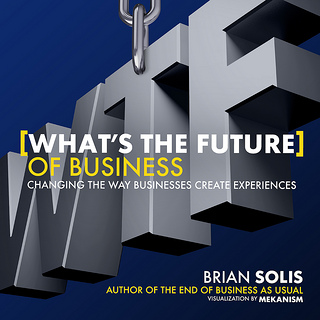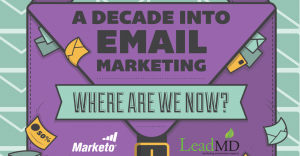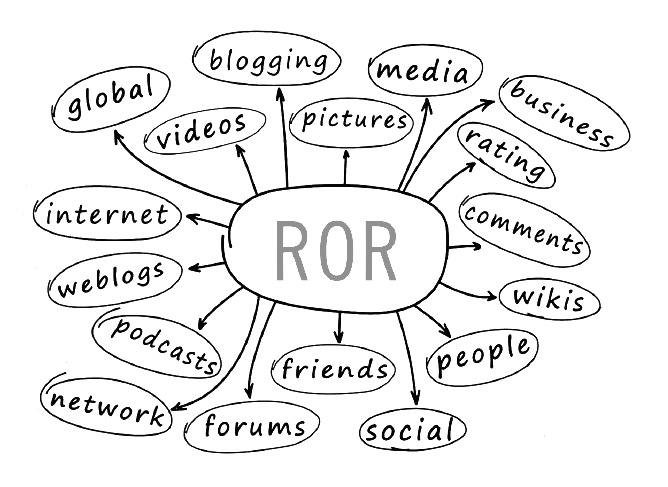 This survey based whitepaper, based on interviews with 229 executives worldwide assesses the challenges and opportunities faced by global businesses as they optimize sales resources to develop territories and incentive compensation plans. This is critical in response to emerging market opportunities and complex global economic challenges.
This survey based whitepaper, based on interviews with 229 executives worldwide assesses the challenges and opportunities faced by global businesses as they optimize sales resources to develop territories and incentive compensation plans. This is critical in response to emerging market opportunities and complex global economic challenges.Download Button
 Have you ever wondered what the future of business will look like? Maybe you figured it’s going to be something like business in the past: buy stuff, sell stuff, try to make a profit by selling stuff for more than it cost you to make it, building a better mousetrap, winning friends and influencing people, crossing the chasm, riding the long tail to the tipping point with the other outliers, going from good to great, and dealing with cheese that keeps moving around.
Have you ever wondered what the future of business will look like? Maybe you figured it’s going to be something like business in the past: buy stuff, sell stuff, try to make a profit by selling stuff for more than it cost you to make it, building a better mousetrap, winning friends and influencing people, crossing the chasm, riding the long tail to the tipping point with the other outliers, going from good to great, and dealing with cheese that keeps moving around.The future of business won't be like that. The future of business is all about dazzling people with amazing customer experiences, says Brian Solis, whose new book, What’s the Future of Business? Changing the Way Businesses Create Experiences, has a cover with the letters “WTF†in huge block letters -- a hint, perhaps, that this is not going to be some ordinary business book, but rather a radical manifesto about change, innovation, and disruption. It's business with a dash of irreverence and punk rock thrown in, a little sneer that says, Look, people, the world has changed, there's this thing called social media, have you heard of it?Â
In this new world, the marketing of products becomes as important as the products themselves. Marketers are the ones who create experiences. Which means suddenly marketers stand at center stage, instead of off in the wings. Suddenly all eyes are on you. Are you ready for your close-up? Read this book and you will be.
The Influencers' Influencer Who is this Brian Solis? Folks at HubSpot know him as a pal who will be speaking at our INBOUND conference this August alongside Arianna Huffington, Seth Godin, and Nate Silver. But according to the book jacket, Solis is “globally recognized as one of the most prominent thought leaders in new media,†as well as a “digital analyst, sociologist, and futurist.â€Â He's an influencer's influencer, whose blog, BrianSolis.com, is considered a must-read for marketers. Solis is a rare web intellectual, a guy who can melt your brain on Twitter but can also think and write convincingly in chunks of more than 140 characters. At INBOUND, Brian will talk about how the pace of innovation has sped up and impacted the pace of change within business overall, and probably expand upon the ideas presented in his book.
His Bold Ideas But what is the book about? It has one big takeaway. Companies are on a journey of transformation. We’re living in an age of digital Darwinism where you must innovate or die, all because consumers are more empowered than ever with the internet at their disposal.
And in this new age, Solis argues that we shouldn't segment these consumers by age -- Generation X, Generation Y, Generation Z, Boomers, and Matures. Instead, we should use “Generation C,†in which the C stands for Connected. Generation C serves as umbrella to describe consumers who are active on the internet and social media, regardless of age. “Gen C is not an age group -- it is a way of life,†he proclaims.
In this worldview, the binary is between those who are Connected and those who are Not Connected. The chief distinction is that, “To Gen C, experience is everything. What they feel about your products and services now and over time is shared through these connected networks.†The challenge for brands is to design the experience that those people will have, and “design the journey that they will embark on.â€
Too many companies are using social media but still not really talking to customers -- and that’s partly why they fail to deliver a complete experience, Solis asserts. Presumably these companies deserve points for trying, and it's nice that they've hired someone to run their Twitter feed, but they’re not making the most of the medium. To paraphrase the late great Steve Jobs: You’re doing it wrong. Solis shows you how to do it right.
What’s the Future of Business: Changing the Way Businesses Create Experiences is an ambitious and ultimately optimistic look at the challenges companies face as they adapt to a digital world, a world where empowered and ever more demanding consumers bring to each transaction a new set of expectations. It’s not just a how-to book, though plenty of advice is offered. Rather it is a call to arms, a call to action, a wake-up call to brands in every industry, a book that will help anyone in marketing do a better job of surfing the storm of change that surrounds us. A must read.
Also, don’t forget to come see Brian Solis speak at the INBOUND conference Aug. 19–22 in good old Boston.
DealerNet Services
 Unless your organization watches its Facebook stats carefully, you may not have realized Facebook has become increasingly less accommodating to brands and companies over the course of the platform’s recent updates. Some notable business owners, like billionaire Dallas Maverick’s owner Mark Cuban, have even spoken out against Facebook’s latest changes.
Unless your organization watches its Facebook stats carefully, you may not have realized Facebook has become increasingly less accommodating to brands and companies over the course of the platform’s recent updates. Some notable business owners, like billionaire Dallas Maverick’s owner Mark Cuban, have even spoken out against Facebook’s latest changes.
For example, in late 2012 TechCrunch noticed that posts made by brand pages were only being displayed to a tiny fraction of a page’s following, and were being hidden from the rest. Facebook has been restricting how many of a page’s followers see a given post, a statistic known as “Reach,†for several years now. However TechCrunch found that in late 2012 Facebook made changes to the newsfeed that caused the reach for brands to drop as much as 40% compared to what it was earlier in the year.
Posts for the average Facebook brand page are now being seen by less than 10% of their audience! For example, if you spent time, money and effort to build your Facebook following to 4,000 people, that means now each post you make is going to be seen by less than 400 of them.
Facebook has a solution for this though…you can pay them money and then they will show your post to more people. That doesn’t quite seem ethical though, does it? First you spend money to build your following on Facebook, and then you spend even more money to reach the following you worked so hard to build?
It’s no wonder so many business owners, like Cuban, are upset and considering leaving the platform. So, is it time for you to close your Facebook page? Here are three important things to consider:
1. Does your business model allow for recurring purchases?  There is a rule in marketing and sales that says it’s always cheaper to sell more to an existing customer than it is to find a new customer. If your business allows for customers to make repeat purchases, like an online store or clothing company with new items every season, then the chances are better that your company will get value from a Facebook page. However, if your customers only need to buy your product once, like a video game or a book, then you will always have to be finding new customers because your product doesn’t lend itself to repeat purchases. That will make it harder for you to come out with a positive return on your Facebook investment if you are continually having to find new customers instead of simply re-selling old ones.
2. Do you have other contact information for your Facebook followers? Depending on your company’s approach to Facebook, you may know that most of the people on your Facebook page got there because they were already following your company on its website, email list, or elsewhere. If that’s the case, there shouldn’t be much negative consequence to closing your Facebook page, because you can still reach those customers another way. However this situation is probably rare, so what can you do if you don’t have other ways to contact your existing Facebook fans?
Start by going to your page and looking at the cost for promoted posts. Figure out how much money you’d wind up spending to reach your desired number of fans each month. This will let you know how much money you can potentially save by moving people to another platform like Twitter, Tumblr, or an email list.
From there, come up with a budget for a contest, and an ad campaign to promote it to your Facebook following, that encourages people to switch to your new platform of choice. This will allow you to justify the expense of the contest and the promotional campaign because you can show that after a certain amount of time, say six months, you will have saved enough money in Facebook expenses to pay for the contest. And every month after that those savings will be contributing to higher profits for your company.
3. How are you measuring the value of your Facebook fans? This is the most important question to ask yourself about whether or not you should keep your Facebook page. Do you know the average revenue generated per fan? Or how many new fans you need to acquire in order for one to make a purchase? Unless you have some way of proving that having a Facebook page is making your company money, you’re running the risk of wasting a substantial amount of time and resources. It’s time for you to start making sure your Facebook page is creating a positive return on investment.
For example, if you know that for every 10 new fans you acquire on average one makes a $20 purchase, then you can look at how much it costs in advertising and administrative costs in order to get 10 new fans. It’s important to factor in the labor and admin costs because those are resources that could be doing something else potentially more effective at generating money for your business if they weren’t tied up running the Facebook page.
So, if it costs you less than $20 to acquire 10 new fans on Facebook, then it’s worth it to keep your page and pay money to grow your following. However, even if you’ve determined that your page is generating positive ROI now, that doesn’t mean that it will continue to do so. Especially if your business doesn’t allow for repeat customers, like the first question pointed out, make sure that you check in on your Facebook ROI regularly.
First, there’s no guarantee that Facebook won’t make changes in the future that will further reduce your ROI. You may also find that as you sell more of your product it will become harder to sustain the same volume of sales. You may reach a point where all of the people who are most likely to buy from you have already done so, and the only people left to target aren’t as interested. This would cause your sales to drop and require you to look at a new strategy to address the changed marketplace.
The bottom line is if you’re going to have a Facebook page, make sure you’ve got a justification for it. And “I’m doing it because all my competitors are doing it†doesn’t count. Just because they like to waste money doesn’t mean you should.
By Alon Popilskis
DealerNet Services
 Are you getting the results you want from your email marketing campaigns? Email marketing has been around for a while now, and there’s a reason it’s such a popular channel in most marketers’ toolboxes. Savvy interactions can deepen customer relationships, inspire new ones, nurture and convert leads, and strengthen brand awareness. By delivering compelling messages tailored to specific customer triggers, marketers can take leads from engagement to purchase.
Are you getting the results you want from your email marketing campaigns? Email marketing has been around for a while now, and there’s a reason it’s such a popular channel in most marketers’ toolboxes. Savvy interactions can deepen customer relationships, inspire new ones, nurture and convert leads, and strengthen brand awareness. By delivering compelling messages tailored to specific customer triggers, marketers can take leads from engagement to purchase.
That said, not every marketer is getting the maximum results possible from their email marketing initiatives. In fact, some are completely missing the boat. To learn more about how to maximize your email marketing initiatives, be sure to download our new ebook, A Decade into Email Marketing: Where Are We Now?
The Evolution of Email Marketing
It’s true that we’ve come a long way from the early days of blast campaigns that usually hit the wrong customers, ended up in the spam filter, or simply created feelings of annoyance and intrusion. In fact, the time has never been better to be a marketer. Technologies like marketing automation allow companies to design polished messages that deliver the most relevant conversations to the right prospect at the perfect time. Lets face it, email has always been a cheap medium as well, with no printing and shipping costs to worry about, email helps mid-market and emerging businesses compete with the big leagues. Consider the cost of executing a digital campaign these days vs. the postage driven campaigns of just a few decades ago and you can see how powerful email is not only in terms of engagement but also as a cost cutting measure.
These days we use email for all kinds of initiatives. Whether we want to reenergize fading leads, deepen engagement with existing customers or launch irresistible upsell and cross-sell offers, we’ve got the tools to tailor our messaging with unprecedented precision. And as mobile rises in popularity with countless users, leads are more connected to their email than ever before.
Creating a Seamless Cross-Channel Experience
So what’s the problem? The truth is that there are so many strategies and channels to consider that many marketers feel overwhelmed. Some are uncertain of which tactics they should be using; some are pursuing unproductive initiatives; some are jumping from strategy to strategy without sticking to one long enough to see results. Still others are applying one overarching plan across all channels, without considering the specific parameters for social and mobile campaigns or the role of smartphones and tablets. To create a seamless cross-channel user experience, email strategies must align with the appropriate platforms.
Authenticity Through Relevance
The rapid evolution of marketing technologies has left many marketers with a skill gap, and others completely in the dust. Even businesses that have invested in good marketing platforms often lack the training to fully understand how segmentation, testing and analytic tools can help them drive ROI and measure campaign performance. Another common issue: the failure to understand the necessity of tailored and engaging content. The days of predictable promotional emails are over, and marketers must create relevant emails that foster an authentic connection with customers. Not only can such relevance make the difference between a delete and a transaction, but techniques such as initiating transactional emails or driving readers to dynamic landing pages on marketing platforms can boost conversions, revenue and brand visibility.
So let me ask you again: are you getting the most you can out of your email marketing campaigns? Are you using the right strategies for the right channels? To help you decide – and learn some new tricks – we’ve put together a new ebook, A Decade into Email Marketing: Where are We Now?, which focuses on deft marketing strategies to help you maximize the potential of this rich marketing tool. We’ll share the 5 pathways to high-impact campaigns that attract, convert and close. Take a look and discover how you can design emails that turn leads into customers and engagement into sales.
Want to learn even more about email marketing? Be sure to pre-register for Marketo’s upcoming Definitive Guide to Engaging Email Marketing available on August 7th!
Author: Justin Gray
DealerNet Services
Â
 In the past, writing skills for B2B marketers weren't as important as being able to source lists and batch send a heavilyproduct-oriented email, hoping someone will open the email and maybe even read it!
In the past, writing skills for B2B marketers weren't as important as being able to source lists and batch send a heavilyproduct-oriented email, hoping someone will open the email and maybe even read it!But it's not so easy these days.
Your buyers are sick of interruption-style marketing tactics, so B2B marketers are switching to content marketing tactics in order to cut through the noise and engage successfully with the target audience.
Content marketing entails drawing buyers to you so they happily part with their details in exchange for information they actually value and want - and that rarely involves talking about your product or service.
So you have to develop your writing skills to be a successful B2B marketer in this day and age. Here are some of the different things you will need to be able to write:
1. Website Copy Because you're most familiar with the buyer personas that you're selling to, you will probably be given the task of writing copy for the entire website - and beyond. This is no easy feat.
Write with SEO (Search Engine Optimisation) in mind Although Google is asking for an emphasis on content and user experience, keywords are still important, because it's what your buyers are searching. You must know how to write for:
- On-site SEO. To make sure your website is easily found, you'll have to think of attractive metadata and meta descriptions. You'll also have to decide on phrases for headings, alt text, and internal links. Then there's the job of writing the actual copy.
- Off-site SEO. Besides guest blogs, off-site SEO is all about social media. These include everything from status updates to personal and company bios.
Build Landing Pages & Calls to Action (CTAs) These are really important, because CTAs entice buyers to visit your landing page, and landing pages entice buyers to convert into contacts. For this reason A/B testing would be a good idea on both to test the language and design you have used.
If you're not sure what kind of copy would be most successful, put up variations and see which one does best when you have a good data set. Your marketing automation software should be able to do this easily.
It's also important to consider how you will structure your forms on these pages. While you must add enough fields to make it easy for yourself to segment your contacts later on, if you're too demanding you will scare people away. You want to have contacts to market to in the first place!
Use Paid Ads Using Google AdWords for PPC or remarketing campaigns can work really well - if you're offering the right thing, in the right way. Remember, people are completely sick of being sold to, so don't be too pushy. Consider what stage of they funnel they're in, and match your offer accordingly.
For example, link to a piece of content if they're still educating themselves. But if they're lower down the funnel and already looking for a solution like yours, that's when you link to a demo, trail or product/services page so they can find out more.
2. High Value Content Buyers don't need to talk to a salesperson until they're ready to buy. When they're doing research, they're making those early buying decisions themselves. Use your high value content to be seen as a trusted source of information when they're in that key stage of their journey.
Write Smart Blog Posts I do not mean press releases about your product, or new hire, or what award you have recently won. None of those blogs will be of any value to your buyer. Resist the urge to talk about yourself and give them some valuable tips that will make their lives easier. Prove to them that you know all about the problems they're facing, and you are happy to share some tips on how they can solve these problems.
Which brings us to our next point.
Develop "Chunky" Content Each blog should have a CTA at the end which serves as a way of converting your blog reader into a contact. But again it has to be of high value to them, aligning with your blog topic. Most of the time, it's something like an eBook, a research report, or a webinar. It can be anything, as long as it's worth it to your buyer. Put yourself in your buyers shoes - what are they looking to get out of the blog? Use an offer that best suits that purpose.
Invest In Case Studies The old school case study still has a place in content marketing - as long as it's written with an inbound twist. This means that you focus more on the experience of the person you're interviewing. How did they feel at the time? What pushed them to realise they had a problem? How did they go about their search? Write as if you're telling a story. You are trying to demonstrate to other potential buyers that you understand their world and have solved their problems before. These work particualrly well at the consideration stage, once your target buyer are past the awareness stage of their buying journey.
3. Emails Writing non-salesy emails can be tricky if you've never done it before - especially if you're sending it to people who don't know who you are yet. It's imperative that you have a strong incentive for them to open, read, and click through your email.
The basic structure should go like this:
- Introduce yourself. Answer the question: Who are you?Â
- State your offer. Answer the reason: Why are you emailing me?
- Reinforce your offer. Answer the question: Why should I care?
- Provide instructions. Answer the question: What should I do next?
Here are three awesome blog posts for further reading:
- 4 Steps to Writing B2B Promos That Actually Work (MarketingProfs)
- 11 Smart Tips for Brilliant Writing (CopyBlogger)
- Copywriting: How to improve headlines on landing pages and blog posts (MarketingSherpa)
Dealer Net Services
 By using an omni-channel approach, the Topshop brand has generated a year’s worth of average Facebook activity in just four days. Photograph: Kin Cheung/AP The exponential growth of digital has created an environment that 20 years ago didn't exist, and even today we are still finding our way around it.
By using an omni-channel approach, the Topshop brand has generated a year’s worth of average Facebook activity in just four days. Photograph: Kin Cheung/AP The exponential growth of digital has created an environment that 20 years ago didn't exist, and even today we are still finding our way around it.Young people have grown up in this digital environment and are unafraid to use it. What is clear is that if we want to survive and prosper in this new digital era, we need to look at not only what it can do for our brands, but also what it can't.
And the one thing that online can't reproduce is the physical interaction between your consumer and the product. Offline gives us the opportunity to fulfil other senses that are involved in making a purchase. A physical place is somewhere to return a product, to have a conversation with someone face-to-face. It's a place where an issue can be resolved immediately. Online customer service has a lot to live up to.
In a recent survey, 60% of respondents said that they expected converged retail channels to be the norm by 2014. But more than half of shoppers said that most retailers lack consistency in the way they present themselves across channels.
Your customers will trust someone who is reliable, consistent in what they say, how they say it and what they promise. But more importantly, they expect to have the same brand experience wherever and whenever they interact with your brand.
The future is omni-channel By 2014, nearly everyone in western Europe and the US will have access to a smartphone connected to the internet. The world is already populated by brand-savvy consumers who are now in control. They say where and when they want to shop, and in some cases, what they are prepared to pay for a product. Retailers can't afford to let any moment of their customer brand experience to be less than rewarding, responsive and reliable.
The future is omni-channel: a mix of all the different ways people like to shop, blended together but all saying the same things. This means in store, on the web, through mobile, TV and social media.
Global research expert Forrester has speculated that the future consumer will want not just responsive interactions but adaptive ones, with content delivered in a way that best suits them as individuals, and their particular device.
Digital experiences will need to be more contextual, possibly including location, purchase history and recommendations. Devices will sync together and with other products allowing people to order from one device and check progress of delivery from another. And information visualisation – shortened to "infovis" – will need to be mainstream.
Brands taking the leadAlthough this digital integration is still in its infancy, some brands are already beginning to adopt it, including Burberry, Topshop, Hollister and M&S. Topshop recently launched a campaign where shoppers received a free styling and make-up session and were invited to create a digital 'Wish you were at Topshop' postcard using Instagram.
Once the postcard photo had been taken, they were given a copy to take home and were also able to upload it to Facebook and the Topshop gallery. To date it has generated 640 blog posts, with a reach of 1.4 million, as well as 5.3m views on Facebook and 2,000 comments. That's a year's worth of its usual Facebook activity in just four days. And as a result, it has become the number one fashion retailer on Instagram.
Or take M&S, a stalwart of the high street, yet embracing online and offline integration with Wi-Fi in store. The brand is also investing in connecting mobile web to the in-store experience. M&S sales assistants will carry tablet devices, and touchscreen kiosks are placed throughout stores to engage shoppers and make customer service easier.
If all channels are connected, customers can start their journey on one channel and complete it on another, creating seamless experiences that increase convenience and engagement, and with consistent brand experience.
Written by Max Eaglen
DealerNet Services
 The psychology of color as it relates to persuasion is one of the most interesting—and most controversial—aspects of marketing.
The psychology of color as it relates to persuasion is one of the most interesting—and most controversial—aspects of marketing.
The reason: Most of today’s conversations on colors and persuasion consist of hunches, anecdotal evidence and advertisers blowing smoke about “colors and the mind.â€
To alleviate this trend and give proper treatment to a truly fascinating element of human behavior, today we’re going to cover a selection of the most reliable research on color theory and persuasion.â¨
Misconceptions around the Psychology of Color
Why does color psychology invoke so much conversation … but is backed with so little factual data?
As research shows, it’s likely because elements such as personal preference, experiences, upbringing, cultural differences, context, etc., often muddy the effect individual colors have on us. So the idea that colors such as yellow or purple are able to invoke some sort of hyper-specific emotion is about as accurate as your standard Tarot card reading.
The conversation is only worsened by incredibly vapid visuals that sum up color psychology with awesome “facts†such as this one:â¨

Don’t fret, though. Now it’s time to take a look at some research-backed insights on how color plays a role in persuasion.â¨
The Importance of Colors in Brandingâ¨
First, let’s address branding, which is one of the most important issues relating to color perception and the area where many articles on this subject run into problems.
There have been numerous attempts to classify consumer responses to different individual colors:â¨

... but the truth of the matter is that color is too dependent on personal experiences to be universally translated to specific feelings.
But there are broader messaging patterns to be found in color perceptions. For instance, colors play a fairly substantial role in purchases and branding.
In an appropriately titled study called Impact of Color in Marketing, researchers found that up to 90% of snap judgments made about products can be based on color alone (depending on the product).â¨
And in regards to the role that color plays in branding, results from studies such as The Interactive Effects of Colors show that the relationship between brands and color hinges on the perceived appropriateness of the color being used for the particular brand (in other words, does the color "fit" what is being sold).â¨
The study Exciting Red and Competent Blue also confirms that purchasing intent is greatly affected by colors due to the impact they have on how a brand is perceived. This means that colors influence how consumers view the "personality" of the brand in question (after all, who would want to buy a Harley Davidson motorcycle if they didn’t get the feeling that Harleys were rugged and cool?).â¨
Additional studies have revealed that our brains prefer recognizable brands, which makes color incredibly important when creating a brand identity. It has even been suggested in Color Research & Application that it is of paramount importance for new brands to specifically target logo colors that ensure differentiation from entrenched competitors (if the competition all uses blue, you'll stand out by using purple).
When it comes to picking the “right†color, research has found that predicting consumer reaction to color appropriateness in relation to the product is far more important than the individual color itself.⨠So, if Harley owners buy the product in order to feel rugged, you could assume that the pink + glitter edition wouldn't sell all that well.
Psychologist and Stanford professor Jennifer Aaker has conducted studies on this very topic via research on Dimensions of Brand Personality, and her studies have found five core dimensions that play a role in a brand’s personality:

(Brands can sometimes cross between two traits, but they are mostly dominated by one. High fashion clothing feels sophisticated, camping gear feels rugged.)
Additional research has shown that there is a real connection between the use of colors and customers’ perceptions of a brand’s personality.â¨
Certain colors DO broadly align with specific traits (e.g., brown with ruggedness, purple with sophistication, and red with excitement). But nearly every academic study on colors and branding will tell you that it’s far more important for your brand’s colors to support the personality you want to portray instead of trying to align with stereotypical color associations.â¨
Consider the inaccuracy of making broad statements such as “green means calm.†The context is missing; sometimes green is used to brand environmental issues such as Timberland’s G.R.E.E.N standard, but other times it’s meant to brand financial spaces such as Mint.com.
And while brown may be useful for a rugged appeal (think Saddleback Leather), when positioned in another context brown can be used to create a warm, inviting feeling (Thanksgiving) or to stir your appetite (every chocolate commercial you’ve ever seen).
Bottom line: I can’t offer you an easy, clear-cut set of guidelines for choosing your brand’s colors, but I can assure you that the context you’re working within is an absolutely essential consideration.
It’s the feeling, mood, and image that your brand creates that play a role in persuasion. Be sure to recognize that colors only come into play when they can be used to match a brand’s desired personality (i.e., the use of white to communicate Apple’s love of clean, simple design).
Without this context, choosing one color over another doesn't make much sense, and there is very little evidence to support that 'orange' will universally make people purchase a product more often than 'silver'.
Color Preferences by Gender
Perceived appropriateness may explain why the most popular car colors are white, black, silver and gray … but is there something else at work that explains why there aren’t very many purple power tools?â¨
One of the better studies on this topic is Joe Hallock’s Colour Assignments. Hallock’s data showcases some clear preferences in certain colors across gender.â¨
It’s important to note that one’s environment—and especially cultural perceptions—plays a strong role in dictating color appropriateness for gender, which in turn can influence individual choices. Consider, for instance, this coverage by Smithsonian magazine detailing how blue became the color for boys and pink was eventually deemed the color for girls (and how it used to be the reverse!).â¨
Here were Hallock’s findings for the most and least favorite colors of men and women:â¨
Men’s Favorite Colors

Women’s Favorite Colors

Men’s Least Favorite Colorsâ¨

Women’s Least Favorite Colors

The most notable points in these images is the supremacy of blue across both genders (it was the favorite color for both groups) and the disparity between groups on purple. Women list purple as a top-tier color, but no men list purple as a favorite color. (Perhaps this is why we have no purple power tools, a product largely associated with men?)
Additional research in studies on color perception and color preferences show that when it comes to shades, tints and hues men seem to prefer bold colors while women prefer softer colors. Also, men were more likely to select shades of colors as their favorites (colors with black added), whereas women were more receptive to tints of colors (colors with white added):


Keep this information in mind when choosing your brand’s primary color palette. Given the starkly different taste preferences shown, it pays to appeal more to men or women if they make up a larger percentage of your ideal buyers.â¨
Continued here The Psychology Of Color In Marketing And Branding
Written by Gregory Ciotti
DealerNet Services
 What sets your company apart from everyone else’s? It’s the brand – and creating a better business starts with this key factor. Without a really good one, nothing sets your enterprise apart from the next one, and this won’t have customers clamoring to do business with you. Therefore, take a hard look at this aspect of your company, and figure out where any changes need to be made. Your business’s brand is essentially your promise to your customer, according to Entrepreneur magazine, and it sets the tone for all future relations. It is what sets you apart, and it is a reflection on everyone who works for a company. With a poor one, even the best products and services could be ignored. When it comes to branding your business, be the industry standard. Let customers know exactly what they are dealing with and the quality of services they should expect.
What sets your company apart from everyone else’s? It’s the brand – and creating a better business starts with this key factor. Without a really good one, nothing sets your enterprise apart from the next one, and this won’t have customers clamoring to do business with you. Therefore, take a hard look at this aspect of your company, and figure out where any changes need to be made. Your business’s brand is essentially your promise to your customer, according to Entrepreneur magazine, and it sets the tone for all future relations. It is what sets you apart, and it is a reflection on everyone who works for a company. With a poor one, even the best products and services could be ignored. When it comes to branding your business, be the industry standard. Let customers know exactly what they are dealing with and the quality of services they should expect.
It all starts with the logo
Not surprisingly, one of the first elements of a brand people see is the logo. That is why it is crucial to make it the best it can possibly be. The logo can make or break a company, and while it is often the first element seen, it can frequently be the last thing remembered. Think about all of the iconic logos - BMW, Coca-Cola, Nike – the list could go on for a long time, but the point is that they are all quite memorable in their simplicity. This is the ultimate goal for branding your business. Create the perfect logo so a customer can’t get it out of their head.
“Other people have to be able to speak for your brand,†said Jonah Berger, associate professor of marketing at the Wharton School of the University of Pennsylvania. “You love your company, you think your company is great, but if you’re not around, what are people going to be able to remember? And what are they going to tell others?â€
Therefore, when starting to craft a brand identity, it is best to keep it simple. The iconic logos previously mentioned all had something in common – simplicity. That is one of the major reasons as to why each one stays in your head. They manage to convey a lot about a company while not being distracting or overly ambitious. For example, Apple started with a more complex version of the logo we all know today. If you remember, it used to be rainbow-colored, and the more intricate predecessor of the plain, black or grayscale version apparent on many tech items today. Berger added that the easier it is to look over a logo, the more desirable it becomes. Apple was smart to simplify - it was less difficult to see the apple and remember with less bells and whistles. Most of the iconic logos have fewer than three colors, and this is for good reason.
To make a company really stand out over a long period of time, the logo also needs to be flexible. What this means is that a company can’t get locked in to an idea. Something that works now might not work in five years, or 10 years, and so on. Perhaps it may not even work in a shorter amount of time, and it is up to management to be able to change quickly and not let affection or ego cloud good business strategy. For example, the Apple logo speaks perfectly to this. The rainbow-colored one was great when the company was a fraction of the global giant it is today, but things change, and the bright, multi-faceted fruit doesn’t convey the same connotations that its monotone counterpart does now.
All of these elements speak to memorability. Don’t make it difficult for a customer to remember your business. Help them along, and at the same time try to convey as much as possible about what the company does. Take a simple concept and give it a small slice of spice, like when Apple decided to take a bite out of its logo.
A great brand should “help them remember that you exist and what you stand for,†added Berger - without a little variety, “it might be easier to process, but [you'd] be less likely to remember, because it looks exactly like a million things you’ve seen before.â€
The best way to know if the methods you use for branding your business are working it to try them. Put a new logo out there and see what people think.
Keep your brand short, sweet, and adaptable
The concepts many businesses use for marketing change often. If your company can’t change right along with them, odds are it won’t succeed. According to Inc. magazine, the old themes of business marketing involved creating a product that has broad appeal, reaching an audience as large as possible and creating a recognizable brand name that can span multiple products. While elements of these hold true in some fashion, the marketing world is evolving, and your company should too.
Due to the growing technologies available today, it requires a different touch to brand well. The Internet and media have divided consumers into smaller categories, and it has also shortened attention spans and has turned many people into the “what have you done for me lately?†types. Therefore, the strategies you use need to be customized to appeal to very specific consumers.
Therefore, a great business brand should target a specific type of person - one that is most likely to buy your product. This brand should attempt to gain support among these consumers, which will help bring new business in. In addition, customer feedback will help define your brand in the future, setting the tone for future marketing strategies. Listen to everyone - social media can be a great way to get instant opinions.
New strategies are more narrow than the older ones, and a business really has to know who its clientele is. The best method for branding your business is to let your consumers dictate the direction. What makes your brand memorable, and what branding strategies do you want to implement in the future?
by Amy Atwood
DealeNet Services
Â
Most C-level Executives, CMO included, View “Social†as Media but…
Tags:
 Most C-level Executives, CMO included, view “Social†as media—but they don’t know how to interact with consumers there in a meaningful way. They want to buy CPMs or Likes—but don’t know what to do with them afterward.
Most C-level Executives, CMO included, view “Social†as media—but they don’t know how to interact with consumers there in a meaningful way. They want to buy CPMs or Likes—but don’t know what to do with them afterward.
CMO’s also make the mistake of assuming that the social audience has the same pain and passion points as their face-to-face or store audience. Most often that is not the case.
In order to get the real value out of Social, you must connect emotionally to the people who are there and find out what they’re looking for. CMOs are used to ads and campaigns, so that’s the place they gravitate, but even Facebook ads are only media buys. Ads are good for building initial likes, but they really are targeted to demographics just like any other ad.
Your mission is to go beyond that initial like and really get people excited about your brand, engage with you, buy from you, become a social advocate and sell for you. To do that you need to get into the heads of your social buyers.
So assign that as a singular goal to appropriate personnel on your team. Make it their mission to follow or friend your followers (not only on Facebook and Twitter, but everywhere online) and listen to their conversations. Their sole mission should be to pay attention to your social consumers. Find out what they like to talk about, the other brands they like, what their problems are–what makes them tick. That’s not a one-and-done task either… it’s ongoing.

by Ted Rubin
DealerNet Services
Have you ever read or heard a truly engaging story? Have you tuned into some television show you couldn't stop watching? What makes the roller coaster ride of a story so thrilling to us?
Well, every great story begins with a prologue that sets the stage and the characters into motion. In order for us to truly be sucked in, the narrator must build a backstory, sometimes with exposition, that connects the audience emotionally to the characters and establishes the themes. Each additional word then slowly thickens the plot and revs the action up until it peaks at some climax; on the way down, the reader or listener fully experiences every jarring twist and red herring the storyline has to offer. Unfortunately, some tales crash and burn, perhaps by leaving the audience in a suspended state of disbelief. But the stories that manage to captivate our attention and make it past the lake of "unresolved subplots" to their final destinations can be a rewarding and entertaining ride!
Â
What's your all-time favorite story? Personally, I'd have to go with the Princess Bride ![]() How can you go wrong with comedy and adventure, mystical forests, jolly giants, and shrieking eels, not to mention badly written true love?
How can you go wrong with comedy and adventure, mystical forests, jolly giants, and shrieking eels, not to mention badly written true love?
Â
comic via incidentalcomics
CALENDAR
CATEGORIES
TAGS
TWITTER POSTS
CALENDAR
- powered by
- One Big Broadcast
- creative by
- WebStager
© 2025 One Big Broadcast | All rights reserved

